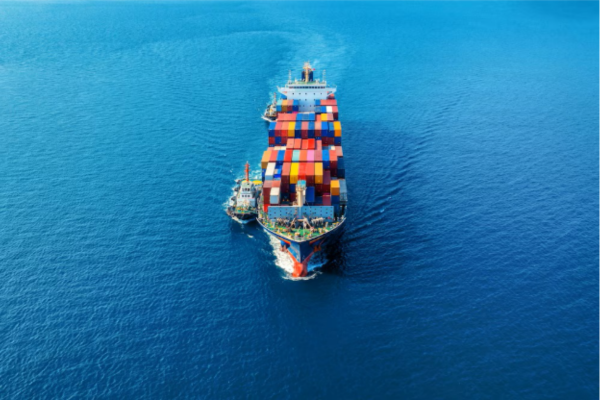Table Of Contents
- How to Estimate Shipping Costs: Sea Distance Calculators Are Bringing Changes
- How to Estimate Shipping Costs with a Sea Distance Calculator?
- Keep Important Shipping Details Ready
- Use the Calculator to Find the Distance and Route
- Understand the Factors that Impact Shipping Costs
- Fuel Surcharges
- Port Charges
- Type of Shipping Container
- Transit Time
- Typo Of the Container
- Seasonal Demand
- Insurance
- Is the Sea Distance Calculator the Ultimate Solution to Measuring the Shipping Costs?
How to Estimate Shipping Costs Using a Sea Distance Calculator?
The global shipping industry is expected to reach USD 23.4 billion by 2032.
- Technological advancements
- Sustainable practices
- Rising global demand
These are the key factors behind this massive growth. However, even today, the question of how to estimate shipping costs remains a concern.
In fact, one of the first questions about shipping goods by sea is how much it will cost. Shipping costs vary greatly depending on several parameters, with the shipping distance being the most significant.
Here is where a sea distance calculator comes in. The calculator estimates the distance your sea freight will cover when you enter the ports of origin and destination.
This article will walk you through how to use such a calculator to estimate your sea shipping charges and help you make an informed choice.
How to Estimate Shipping Costs: Sea Distance Calculators Are Bringing Changes
- Shipping companies use a sea distance calculator, which is a tool that helps calculate the distance between the port of origin and the destination port.
- The calculator considers factors like currents, weather, and terrain to provide an approximate shipping fee.
- Shipping companies estimate the shipping costs beforehand while calculating the distance between two ports.
How to Estimate Shipping Costs with a Sea Distance Calculator?
Follow these steps to estimate shipping costs.
Keep Important Shipping Details Ready
- The port of origin and destination
- The type of cargo affects the shipping cost and route. Indicate whether your shipment needs a container, is a liquid, or contains food and medicines that require special temperature-controlled handling.
- A close approximation of your sea freight’s volume and weight.
- Choose if your cargo will take up an entire container or share a container with other cargo.
Use the Calculator to Find the Distance and Route
Choose one of the many sea distance calculators available online and enter your departure and destination ports. Click on search to get the following results.
- The distance your shipment will travel by sea is usually expressed in nautical miles or kilometers.
- An estimate of the time that your shipment will take to reach your destination. This is calculated based on the average speed of cargo ships.
- Many calculators also give a sea route map with stops and numerous freight transfer points.
Understand the Factors that Impact Shipping Costs
Now that you have the shipping distance, you can calculate the shipping costs by getting quotes from several sea cargo operators. Let’s understand the other factors that can affect your sea cargo quote.
Fuel Surcharges
- A ship consumes more fuel when it has to cover longer routes.
- The fuel price also varies according to global oil markets and the type of fuel consumed.
Port Charges
- Every time your sea freight is loaded or unloaded in a port, it incurs port, customs, and handling fees.
- These charges can significantly increase your shipping costs if your shipment passes through multiple ports.
In this context, you must know that various public and private initiatives are being taken to improve the port infrastructure to keep the costs in check.
Moreover, various transshipment hubs are being built so that cargo can be transferred from one ship to another easily. It saves a lot of time and effort.
Type of Shipping Container
- The type of shipping container can increase shipping costs.
- Dangerous goods, and oversized, or temperature-controlled shipments require special containers that can cost more.
Transit Time
- You can opt for express sea shipping if you are shipping perishable or time-sensitive goods.
- You would have to pay more if you opt for faster shipping.
Typo Of the Container
The shipping charges may vary depending on the type of cargo. There are two types of cargo:
FCL:
When a full container is shipped, the shipping cost is flat. These are called FCL, which means Full Container Load.
The charges of transportation with the FCL are generally less.
LCL:
LCL refers to less than a container. When the cargo is less than the volume of the container, the calculations mostly happen on the basis of volume or weight.
Transporters measure LCL on the basis of the volume measured in cubic meters or CBM.
Seasonal Demand
Shipping costs can increase during peak seasons, adding to the costs.
“Seasonal demand is an important factor if you want to know how to estimate shipping costs.
For example, during the New Year and Christmas or even Easter, everyone is buying a present for their family and friends.
So, the volume we need to deliver is huge. We also need additional resources to keep up with the growing demand.
Therefore, even if we don’t want to, we have to increase the costs.”
- Delnaz, A Finance Professional with 10 Years of Experience in the Shipping Industry.
Insurance
The costs associated with insuring the sea cargo also contribute to the total shipping costs.
However, at this stage, you must also consider that proper coverage is more crucial than the pricing.
You don’t need to overinsure the service or the damages. However, underinsurance can be an even bigger peril.
Especially these days, geopolitical tensions are frequent. So, there can be issues during cargo shipping.
Again, you can never predict sudden natural calamities.
So, even if costs are directly related to shipping charges, there cannot be any compromise.
Is the Sea Distance Calculator the Ultimate Solution to Measuring the Shipping Costs?
A sea distance calculator provides the distance your freight will travel and offers a better understanding of the shipping route.
The tool doesn’t provide a precise price quote, but it’s a good starting point to estimate your shipping cost.
You can then use this as a point of reference to ask the correct questions and make the right decisions about your sea cargo.
There will always be some unforeseen factors, such as sudden changes in the route, natural disasters, and geopolitical restrictions.
So, a sea distance calculator or shipping cost calculator cannot replace human intervention in analyzing historical data, understanding trends, assessing risk factors, and then creating a budget.
Moreover, you can integrate automation and artificial intelligence into your system for more accurate analysis and cost prediction.














